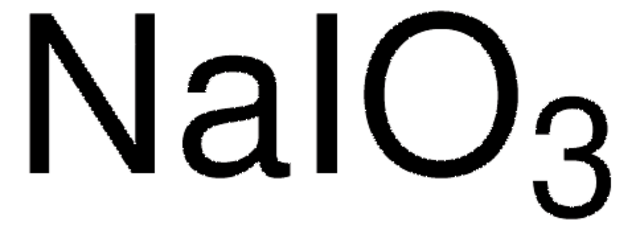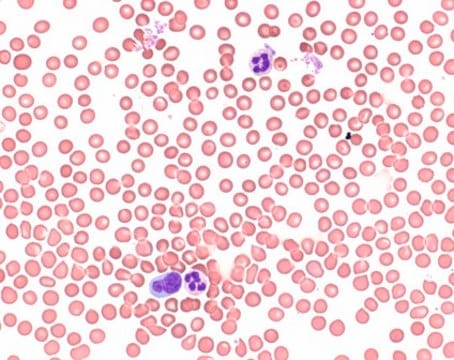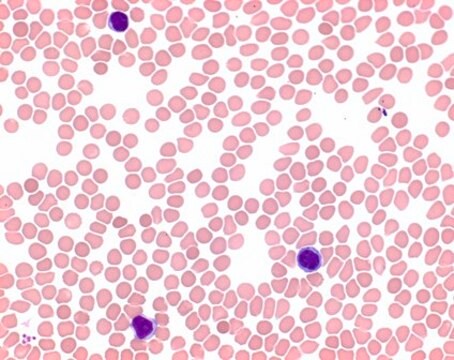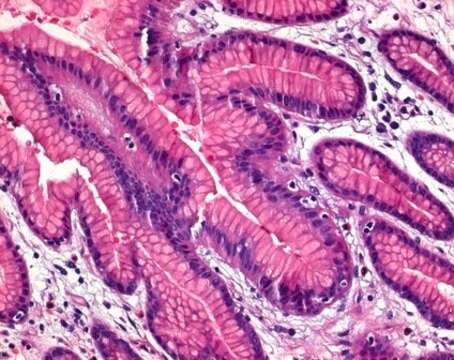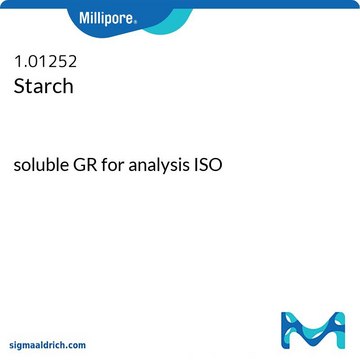1.06525
Sodium iodate
for analysis EMSURE®
Synonyme(s) :
Sodium iodate
About This Item
Produits recommandés
Niveau de qualité
Gamme de produits
EMSURE®
Essai
≥99.5% (iodometric)
Forme
solid
pH
5.8 (25 °C, 90 g/L in H2O)
Solubilité
81 g/L
Densité
4.28 g/cm3 at 20 °C
Masse volumique apparente
1150 kg/m3
Traces d'anions
bromide, bromate, chloride, chlorate (as Cl-): ≤0.02%
iodide (I-): ≤0.002%
sulfate (SO42-): ≤0.005%
Traces de cations
Cd: ≤0.00005%
Cu: ≤0.0001%
Fe: ≤0.001%
K: ≤0.02%
Mn: ≤0.00005%
N: ≤0.002%
Pb: ≤0.0002%
Zn: ≤0.0001%
Température de stockage
2-30°C
Chaîne SMILES
[Na+].[I](=O)(=O)[O-]
InChI
1S/HIO3.Na/c2-1(3)4;/h(H,2,3,4);/q;+1/p-1
Clé InChI
WTCBONOLBHEDIL-UHFFFAOYSA-M
Application
- Comparative Analysis of Molecular Landscape in Mouse Models and Patients Reveals Conserved Inflammation Pathways in Age-Related Macular Degeneration.: This study highlights the use of sodium iodate to induce retinal degeneration in mouse models to explore conserved inflammation pathways relevant to age-related macular degeneration. This model provides insights into potential therapeutic targets for inflammatory diseases of the retina (Liu et al., 2024).
- The BET PROTAC inhibitor dBET6 protects against retinal degeneration and inhibits the cGAS-STING in response to light damage.: Sodium iodate was utilized to model retinal degeneration, showing the effectiveness of the BET PROTAC inhibitor dBET6 in protecting against retinal damage and modulating inflammatory responses, potentially offering new treatment avenues for retinal diseases (Zhu et al., 2023).
- Sodium Iodate-Induced Degeneration Results in Local Complement Changes and Inflammatory Processes in Murine Retina.: This research delves into the specific inflammatory processes and complement system changes following sodium iodate-induced retinal degeneration in mice, providing a detailed molecular understanding of retinal inflammatory responses (Enzbrenner et al., 2021).
- IL-33trap-mediated IL-33 neutralization does not exacerbate choroidal neovascularization, but fails to protect against retinal degeneration in a dry age-related macular degeneration model.: The study used sodium iodate to induce retinal degeneration and test IL-33 neutralization′s effectiveness in preventing retinal damage, contributing to the understanding of inflammatory pathways in retinal diseases (Van Hove et al., 2021).
- An Acute Injury Model for the Phenotypic Characteristics of Geographic Atrophy.: Utilizing sodium iodate to create an acute retinal injury model, this study mimics the phenotypic characteristics of geographic atrophy, providing a valuable tool for studying this condition and testing potential treatments (Bhutto et al., 2018).
Remarque sur l'analyse
pH-value (5 %; water): 5 - 8
Chloride, Chlorate, Bromide, Bromate (as Cl): ≤ 0.02 %
Iodide (I): ≤ 0.002 %
Sulfate (SO₄): ≤ 0.005 %
Total nitrogen (N): ≤ 0.002 %
Cd (Cadmium): ≤ 0.00005 %
Cu (Copper): ≤ 0.0001 %
Fe (Iron): ≤ 0.001 %
K (Potassium): ≤ 0.02 %
Mn (Manganese): ≤ 0.00005 %
Pb (Lead): ≤ 0.0002 %
Zn (Zinc): ≤ 0.0001 %
Informations légales
Mention d'avertissement
Danger
Mentions de danger
Conseils de prudence
Classification des risques
Acute Tox. 4 Oral - Ox. Sol. 2 - Resp. Sens. 1 - Skin Sens. 1
Code de la classe de stockage
5.1B - Oxidizing hazardous materials
Classe de danger pour l'eau (WGK)
WGK 1
Point d'éclair (°F)
Not applicable
Point d'éclair (°C)
Not applicable
Certificats d'analyse (COA)
Recherchez un Certificats d'analyse (COA) en saisissant le numéro de lot du produit. Les numéros de lot figurent sur l'étiquette du produit après les mots "Lot" ou "Batch".
Déjà en possession de ce produit ?
Retrouvez la documentation relative aux produits que vous avez récemment achetés dans la Bibliothèque de documents.
Notre équipe de scientifiques dispose d'une expérience dans tous les secteurs de la recherche, notamment en sciences de la vie, science des matériaux, synthèse chimique, chromatographie, analyse et dans de nombreux autres domaines..
Contacter notre Service technique